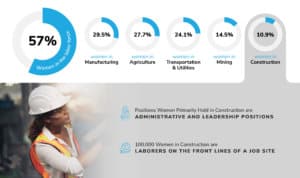Like most trade professions, men make up most of the workforce in the construction industry. Although you may be surprised to learn how many women work in construction, the demographics of construction workers could soon shift further toward more inclusivity.
In mid-2022, the Biden Administration launched the Talent Pipeline Challenge, a new initiative for the equitable development of the infrastructure workforce. The challenge encourages employers, training providers, and state and local governments to not only bring on workers but create more pathways for women and people of color to join all infrastructure sectors, including construction.
Breaking Ground for More Women in Construction
This push for hiring also comes during a nationwide shortage of construction laborers, with over half a million residential and nonresidential construction positions sitting unfilled. More women in construction could help bridge this gap.
Just over 57 percent of all women participate in the labor force: however, “women were substantially underrepresented (relative to their share of total employment) in manufacturing (29.5 percent), agriculture (27.7 percent), transportation and utilities (24.1 percent), mining (14.5 percent), and construction (10.9 percent),” according to the latest databook from the Bureau of Labor Statistics.

Of the 11 percent of women in construction, many hold administrative and leadership positions, while around 100,000 are laborers on the front lines of a job site — research from the Institute for Women’s Policy shows this is a significant increase in female laborers since 2016, indicating more room to grow over the coming years.
Is Construction More Dangerous for Women in the Field?
Female construction workers may face more risk of personal injury on the job compared to their male counterparts. Although the Bureau of Labor Statistics collects and reports comprehensive data on occupational fatal and nonfatal injuries among construction workers, it isn’t granular enough to reveal much about how many women are hurt or killed in construction jobs.
In a report by the New York Committee for Occupational Safety and Health (NYCOSH), one study found that women had higher rates of sprains, strains, and nerve conditions of the wrist and forearm than men. But overall, the lack of data highlights a need for further research and a breakdown of workplace injury data on women specifically.

While data on women hurt or killed in construction accidents is sparse, the NYCOSH report explored some other risks women in construction face, such as:
Challenging Ergonomics

The physical differences between men and women can pose difficulties for women in construction jobs since most of the common equipment and tools used are designed for larger hands and overall stronger body types. When women aren’t provided proper tools or are pushed beyond their physical limits, they face a greater risk of injury.
Improper Personal Protective Equipment (PPE)

In addition to challenges using construction tools and equipment, women can also be hurt if they don’t have proper PPE for the job, such as hats, boots, and high visibility vests. OSHA states that PPE should be fitted to each worker’s body measurements and many sizes are available — when it comes to PPE, one size doesn’t fit all.
Reproductive Hazards

Little data exists on how reproductive hazards affect women who are pregnant or may become pregnant. Common construction site hazards such as dust, lead, and other chemicals are dangerous for all construction workers but may pose a greater risk to expectant mothers. The CDC suggests this risk can be mitigated with proper PPE and by closely following safety practices in the workplace, but women still face health exposure.
Inadequate Training

In 1999, an OSHA report documented the concerns of some female construction workers regarding inadequate training, lack of support, and less “general acceptance” and trust from male colleagues to learn new skills or complete tasks. When women aren’t given the same opportunities for mentorship and coaching from coworkers and superiors, there’s a greater chance they won’t receive critical information about their work, creating a greater chance for injury.
Other Challenges for Women in Construction
Beyond physical dangers, women in construction can also face stressful or even hostile work environments. Although apprenticeships in male-dominated industries can offer better-paying opportunities than stereotypical “women’s work,” women at many levels — from laborers to the C-suite — unfortunately report being denied training or experiencing sexual harassment in training and on the job.
A Brighter Future for Women in Construction?

Everyone in the construction industry has a responsibility to keep female workers safe, from employer and labor unions to safety and regulatory agencies. Women have come a long way in terms of representation in historically male-dominated fields, but with more potentially joining the construction workforce, steps should be taken to ensure that those fields are as safe for them as they are for their male colleagues.
A brief by the Institute for Women’s Policy emphasizes the value of more women joining construction and other trades:
“Having clear data can create accountability and help policymakers ensure that tradeswomen have access to sustainable careers, with adequate work hours, workplace policies that support work/family balance, comprehensive on-the-job training and freedom from bias and sexual and racial harassment. The industry as a whole benefits greatly from access to the skilled work of tradeswomen.”
Despite the risks and challenges women in construction face, trade workers are in high demand, and employers are raising pay to help meet the call — particularly in the homebuilding sector, where the rate of wage growth is at its highest in over 40 years. The general outlook for growth in the construction industry is on par with other trades, but the immediate need and relative ease of entry makes a career in construction worth considering.

